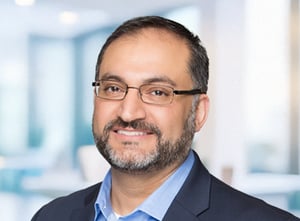Energy & Utilities (E&U) companies are undergoing large-scale transformation, driven by a race to decarbonization and supported by new public funding. Amidst the shift from fossil fuels to renewable, low-carbon energy sources—known widely as “the energy transition”— the industry is facing a significant challenge to respond and scale, primarily related to a transitioning workforce, skills shortages, and demands for greater cost efficiency at point of sale and value delivery for ratepayers. Energy transition is no small transformation—it will require a comprehensive overhaul of the industry’s legacy operations, processes, ways of working, technology and data infrastructure and capabilities, and more. Tomorrow’s E&U leaders will approach today’s energy transition as an opportunity to shed outdated practices and adopt a mindset that embraces continuous, incremental change as a way of being. Transformation Thinking, which brings together design, systems, and scenario thinking, will be a valuable asset in navigating the energy transition. By applying these three complementary schools of thought, E&U organizations will have the foresight to effectively anticipate the outcomes and implications of energy transition and continuously integrate customer requirements into every aspect of their evolving enterprise. They will be equipped to handle changing market and labor conditions, drive sustainable initiatives, effectively manage public funding, and achieve long-term success in their transition efforts. Discover the full potential of Transformation Thinking by downloading our perspective, "The Three Schools of Thought That Matter.” This piece includes a step-by-step checklist to assist you in effectively incorporating and implementing Transformation Thinking into your E&U business operations.
With the Covid-19 pandemic largely contained, the Life Sciences industry is now turning its focus toward the future while drawing upon the experiences of the past few years. Having successfully led the world in navigating the global health crisis—while at the same time facing supply chain obstacles and workforce challenges—the industry knows firsthand that the organizations that thrive in times of transformation behave more like organisms than machines. They evolve and adapt. To continue evolving, Life Sciences organizations know that the next big challenge involves shedding traditional business models and embracing an omnichannel approach with new data, technologies, ambitions, and revenue streams to grow and compete. Transformation Thinking—which brings together design, systems, and scenario thinking—can help the industry begin its next big breakthrough. When it comes to the industry’s commercial operations, for instance, the combination of design, systems, and scenario thinking can help Life Sciences players best optimize operations, realize economies of scale, and build an omnichannel patient engagement ecosystem of the future. For shared services and programs, the holistic, customer-centric approach that is Transformation Thinking can help leaders achieve a sustainable symbiosis between systems, people, processes, culture, technology, and high-touch engagement to fuel performance improvement today while embedding future-ready ways of operating for tomorrow. With Transformation Thinking, industry leaders will also tap into the potential of data & analytics and AI, to better predict emerging customer, patient, and workforce needs to be ready for what comes next. Learn more about the potential of Transformation Thinking for the Life Sciences industry by reading the full perspective below.
While there is significant public funding available to transportation organizations today, the industry is also facing a bounty of challenges, namely a decline in public transportation ridership, overwhelming demand for freight and cargo, and pressure to become safer, cleaner, and more equitable post-pandemic. To tackle these challenges head-on, the industry is striving to revamp passenger experiences with enhanced solutions, embrace operational flexibility to balance supply with demand, build digital dexterity among the workforce to prepare for the impending “silver tsunami” (or generational shift that will phase out legacy employees’ knowledge and talent), and much more. The industry can apply a blend of design, systems, and scenario thinking—a mindset we call Transformation Thinking—to effectively navigate each of these objectives and stay competitive in the future. These three schools of thought can help transportation leaders implement Mobility as a Service (MaaS)—a single solution that integrates applications, routes, and digital payments—to amplify all modes of transportation and enhance passenger experiences. By placing passengers at the core of the design process, for example, leaders can be confident the MaaS solution they’re building will deliver on its promise of enhanced experiences. Incorporating systems thinking, transportation leaders will be pushed to adopt a holistic approach that considers the ripple effects of the solution on the full enterprise ecosystem—from back-office processes, data, and ways of working to transformative technologies for passengers. Scenario thinking projects design and system thinking forward into multiple futures, allowing transportation leaders to plan for potential evolutions and new applications of the MaaS solution. This positions a business to continue delivering top-notch experiences for passengers as their preferences, and the data and tech available to the transportation industry, continue to rapidly evolve. Discover additional ways Transformation Thinking can support your transportation business operations by reading the full perspective below.
The retail and consumer packaged goods (CPG) industry has proven its resilience in the face of the Covid-19 pandemic, emerging stronger and more agile. However, with continued economic uncertainty, supply chain fragility, workforce challenges, and ever-changing customer expectations, the industry faces both legacy and unprecedented challenges. To thrive in this dynamic landscape, retailers must adopt a "made-for-change" mindset, achieved through a blend of design, systems, and scenario thinking. This approach, which we’ve coined "Transformation Thinking," empowers retailers to drive value, optimize flexibility, and manage risk. For instance, in the event of a possible recession, retailers can leverage scenario thinking to identify signals and drivers of the recession, map out potential futures based on signals of change, uncertainties, and potential risks, and consider the implications of those futures for the business. With the help of design thinking, leaders and teams can prioritize and pilot solutions that enable the business to navigate the recession effectively while meeting the needs of those who matter most: customers. Systems thinking then prompts retailers to consider how the recession and proposed solutions will impact the ecosystem of their business. In the below perspective, we provide an in-depth look at Transformation Thinking, along with a step-by-step checklist that retailers can put into practice to navigate a plausible recession and other challenges that lie ahead.
The pandemic dealt a heavy blow to the hospitality industry, forcing hotels, restaurants, airlines, and theme parks to grapple with closures and staff layoffs. But the franchise market demonstrated its adaptability and resilience. As franchise units continue to surge, surpassing pre-pandemic levels, those who operate them are presented with a golden chance: outpace competitors by evolving at an accelerated pace. Transformation Thinking, which blends design, systems, and scenario thinking, can assist franchise owners in modernizing their legacy systems and ways of working to optimize service and standardize operations across multiple locations. Design thinking helps owners foster more empathy for customers, generate innovative ideas, and enable iterative problem-solving. It drives customer-centric solutions, promotes collaboration, and enhances overall business performance. Systems thinking equips franchise owners with a comprehensive grasp of the business ecosystem, enabling them to address systemic issues, optimize resource allocation, improve processes, establish feedback loops for continuous improvement, and anticipate evolving customer needs. Scenario thinking empowers owners to envision future possibilities, identify emerging trends and challenges, promote flexible planning and decision-making, foster innovation and experimentation, and facilitate continuous monitoring and adaptation. These three schools of thought offer vast possibilities for the hospitality industry. Discover their transformative power in our perspective, "The Three Schools of Thought That Matter."
As HHS agencies receive more funding to address mounting regulatory pressures and constituent expectations, they are investing in the promise of an integrated, interoperable future. However, silos and boundaries, whether actual or perceived, can create dangerous blind spots on the path toward interoperability. To make good on their promise, state HHS agencies can apply "Transformation Thinking," which combines three contemporary schools of thought: design, systems, and scenario thinking. For instance, Transformation Thinking can help HHS agencies improve their data management practices to enable seamless sharing of information and integration of services in support of interoperability. By utilizing design thinking, HHS leaders can approach data and analytics (D&A) solutions with a constituent-centered mindset, integrating and applying data to programs and services to meet the unique needs of their constituents and creating interoperable, outcomes-driven, and whole-person health ecosystems. Systems thinking allows HHS leaders to take a holistic, dynamic approach to interoperability by considering interdependencies in programs and services, identifying the factors that contribute to interoperability challenges (i.e., data, technological, organizational, and cultural barriers), standardizing data formats to ensure compatibility, improving processes to support data exchange, and more. Scenario thinking helps HHS agencies anticipate plausible future scenarios and plan their data management practices accordingly, ensuring that they are prepared to respond to changing circumstances, such as those tied to regulations and funding. By embracing these three schools of thought, HHS agencies can establish a sustainable, data-driven path toward interoperability and system integration. Download the full perspective to learn more about Transformation Thinking.
Emergency management (EM) organizations are facing a surge in the frequency and cost of natural disasters, in addition to more intricate, extensive, and consequential man-made crises. Meanwhile, they are grappling with limited resources and mounting pressure to respond promptly and with complete transparency to these emergencies. That’s why it’s essential for state and local governments to enhance their management of federal funding to ensure optimal effectiveness in addressing these challenges. Transformation Thinking, which brings together design, systems, and scenario thinking, will be a valuable tool to help EM organizations achieve this goal. By applying design thinking principles, EM agencies can better understand the needs of those who manage and/or are impacted by funding programs, identify opportunities for improvement, and develop more effective strategies for leveraging these resources. For instance, design thinking could prompt EM leaders to develop a user-friendly web portal for accessing funding administration information or create training programs targeted to the specific needs of EM personnel. This can generate better outcomes for communities and create greater transparency and accountability in the management of funding programs. Employing systems thinking can provide EM organizations with a more comprehensive grasp of the intricate interdependencies and complexities associated with funding programs. This may necessitate the mapping of diverse processes, stakeholders, resources, and regulations linked to funding sources, and pinpointing areas where enhancements can be implemented. Real-time data can support systems thinking by enabling agencies to monitor funding utilization. To develop contingency plans for managing funding programs under diverse circumstances faced by EM organizations, such as a pandemic, cyber attack, or natural disaster, EM organizations can use scenario thinking. With temporary shelter and permanent housing solutions a major challenge for all EM organizations, scenario thinking brings a level of planning that can tackle these difficult situations. This approach entails thinking through plausible scenarios that account for varying funding levels, timelines, citizen and business needs, regulations at all levels of government, and requirements, and determining tactics for responding to each. This helps EM organizations ensure that funding is distributed appropriately, efficiently, and effectively, thereby bolstering their resilience and preparedness to respond to emergencies and disasters. Discover the full potential of Transformation Thinking by downloading our perspective, "The Three Schools of Thought That Matter.”
The healthcare industry continues to transform through advancements in technology that have contributed to improved patient outcomes. But it’s critical to acknowledge both the positive and negative impacts of these advancements on the healthcare workforce. Positive experiences undoubtedly lead to better patient outcomes, while negative ones, such as burnout, can adversely affect the overall quality of care. The tech rush of 2021, for example, did not support enterprise-level digital dexterity and contributed to a heavier workload and more stress for healthcare employees. As the industry continues to optimize legacy systems and implement new technology to improve ways of working and enhance patient engagement, a combination of design, systems, and scenario thinking should be employed for optimal results. We call these three schools of thought “Transformation Thinking.” Here’s how it works: Design thinking urges leaders to center every decision around employees and patients, including co-creating solutions, prioritizing usability, testing and integrating feedback, and providing training and support. Meanwhile, systems thinking requires leaders to assess technology's impact on the entire healthcare system, including patients, healthcare providers, and other stakeholders. This involves identifying and addressing interdependencies, anticipating unintended consequences, optimizing resource allocation, and promoting collaboration and communication. By using scenario thinking, healthcare organizations can anticipate potential challenges related to technology advancements and develop proactive strategies to mitigate the negative impact on employee well-being. Learn more about the application of Transformation Thinking by reading the full perspective.







